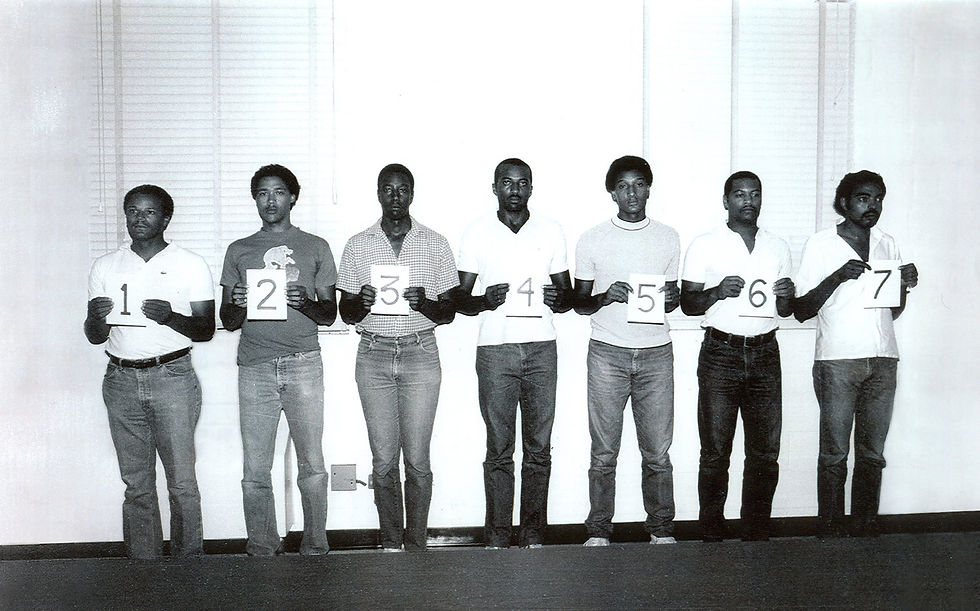INFAMOUS: Jennifer Thompson and Ronald Cotton
- Yasmin Sudarsanam
- Dec 28, 2024
- 4 min read
Trigger Warning: The following case includes depictions of sexual assault. Please read at your own discretion.
In my psychology class, we’ve been delving into how memories are encoded and recovered, and how vulnerable that process can be to misinformation or manipulation—whether intentional or accidental. During one lecture, our professor showed us an interview clip with Jennifer Thompson, a woman whose story encapsulates the devastating consequences of flawed memory and its impact on justice. Her story inspired me to explore her case and raise awareness about wrongful convictions and the often unreliable nature of eyewitness testimony. This is the story of Jennifer Thompson and Ronald Cotton.

On July 29, 1984, Jennifer Thompson, a 22-year-old college student in Burlington, North Carolina, experienced a life-altering incident. A man broke into her home, held her at knifepoint, and sexually assaulted her. That same night, he attacked another woman. During the assault, Thompson, remarkably composed, fixated on her attacker’s face, determined to memorize every detail to seek justice later. When she reported the crime to police, the investigation quickly moved forward, and she was presented with a photo lineup. Among the images, she identified Ronald Cotton as her assailant.
At trial, Thompson’s testimony was the prosecution’s centerpiece. Calm and confident, she pointed to Cotton as the man who had attacked her. Additional evidence included a flashlight found in Cotton’s home resembling one used during the attack and a comparison of the sole of Cotton’s shoe to rubber traces left at another crime scene that night. However, none of this evidence was conclusive. The case’s foundation rested entirely on Thompson’s unwavering identification.
The jury found Cotton guilty of sexual assault and burglary, sentencing him to life in prison plus an additional fifty-four years. Cotton maintained his innocence and eventually won a second trial. This time, he took the stand to defend himself. Yet, the outcome remained the same. Both victims testified again, affirming that Cotton was their attacker. Once again, the jury convicted him.
For over a decade, Ronald Cotton proclaimed his innocence, appealing his case repeatedly. In March 1995, a pivotal moment came when his lawyers requested retesting of DNA evidence collected from Thompson’s rape kit. The results were undeniable—Cotton’s DNA was not present in the samples, making it impossible for him to have been the perpetrator. The district attorney and defense moved to dismiss all charges, and on June 30, 1995, Ronald Cotton was exonerated and released from prison after serving over ten years for a crime he did not commit.

Investigators later linked Thompson’s case to another assault victim from that night, Mary Williams. DNA from Williams’ kit matched Bobby Poole, another inmate who happened to be incarcerated in the same prison as Cotton. Poole bore a striking resemblance to Cotton, and the two were often mistaken for one another. Shockingly, Poole had even attended Cotton’s second trial. Despite his presence, both victims identified Cotton as the perpetrator instead of Poole. Poole, who had repeatedly boasted to fellow inmates about committing the assaults without being caught, eventually confessed to the crimes. He was sentenced to seventy years in prison, where he remained until his death from cancer in 2000.
Jennifer Thompson, devastated upon learning the truth, became an outspoken advocate for criminal justice reform, focusing on the fallibility of eyewitness testimony. Despite her determination to bring her attacker to justice, her identification had led to an innocent man’s imprisonment. Thompson’s case is a striking example of how even the most well-intentioned eyewitnesses—calm, studious, detail-oriented—can be profoundly mistaken.

One of the key issues in Thompson’s case was the flawed lineup procedure. Victims are often unaware that the actual perpetrator’s face may not be included in the photos or lineup they are shown. Instead, they tend to choose the person whose face most closely resembles their memory, rather than an exact match. Investigators can also unintentionally influence a victim’s decision with suggestive comments like, “We thought that was the one,” or even subtle cues like body language. Thompson herself wavered when presented with the six mugshots before tentatively selecting Cotton’s picture. Her initial hesitation might have been forgotten due to a comment from the detective, which reinforced her confidence in her choice. Studies show that a witness’s confidence at the time of selection correlates with their accuracy, but confidence can be falsely bolstered by external influences. Advocates for criminal justice reform have since pushed for “double-blind” lineup procedures, where neither the investigator nor the witness knows the suspect’s identity. This practice is now mandatory in thirteen states, which also require witnesses to record their confidence levels when identifying a suspect. Twelve additional states recommend these measures.

Thompson’s story also illustrates how memories can change over time. She later admitted that her memory of her attacker had morphed to fit Ronald Cotton’s face—a phenomenon psychologists call “retroactive interference,” where new information interferes with existing memories. Remarkably, Thompson and Cotton have turned their shared experience into a powerful force for change. Today, they are close friends and work together to promote eyewitness testimony reform across the nation. Their story serves as a sobering reminder of the flaws in our justice system and the human cost of wrongful convictions—and the resilience of two people determined to make a difference.
Feel free to leave your thoughts, opinions, and questions below!
Sources:




Comments